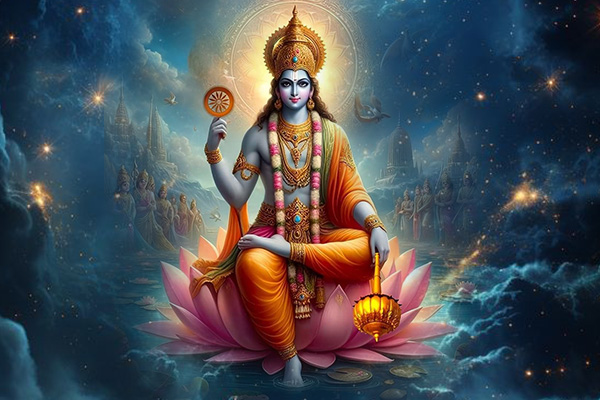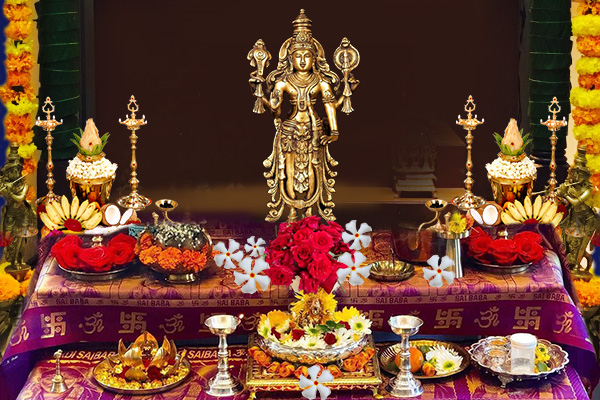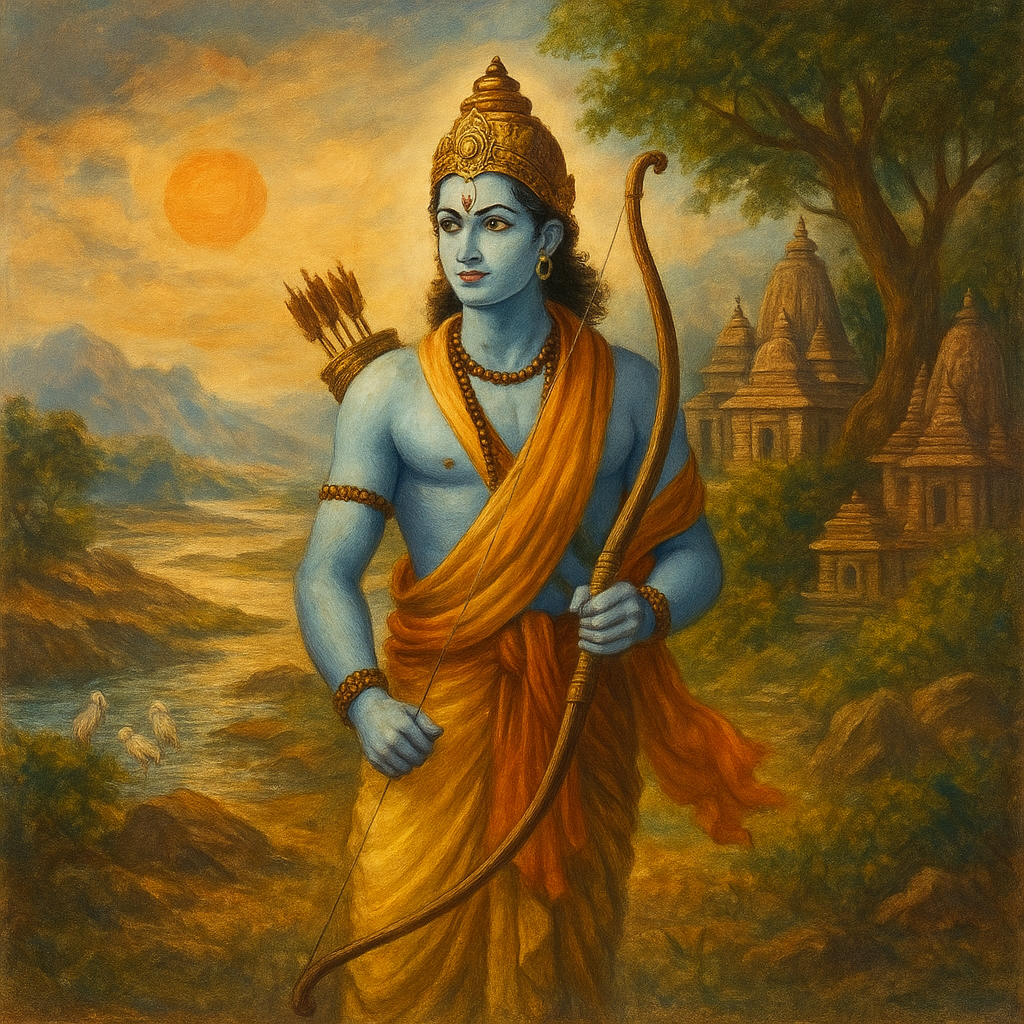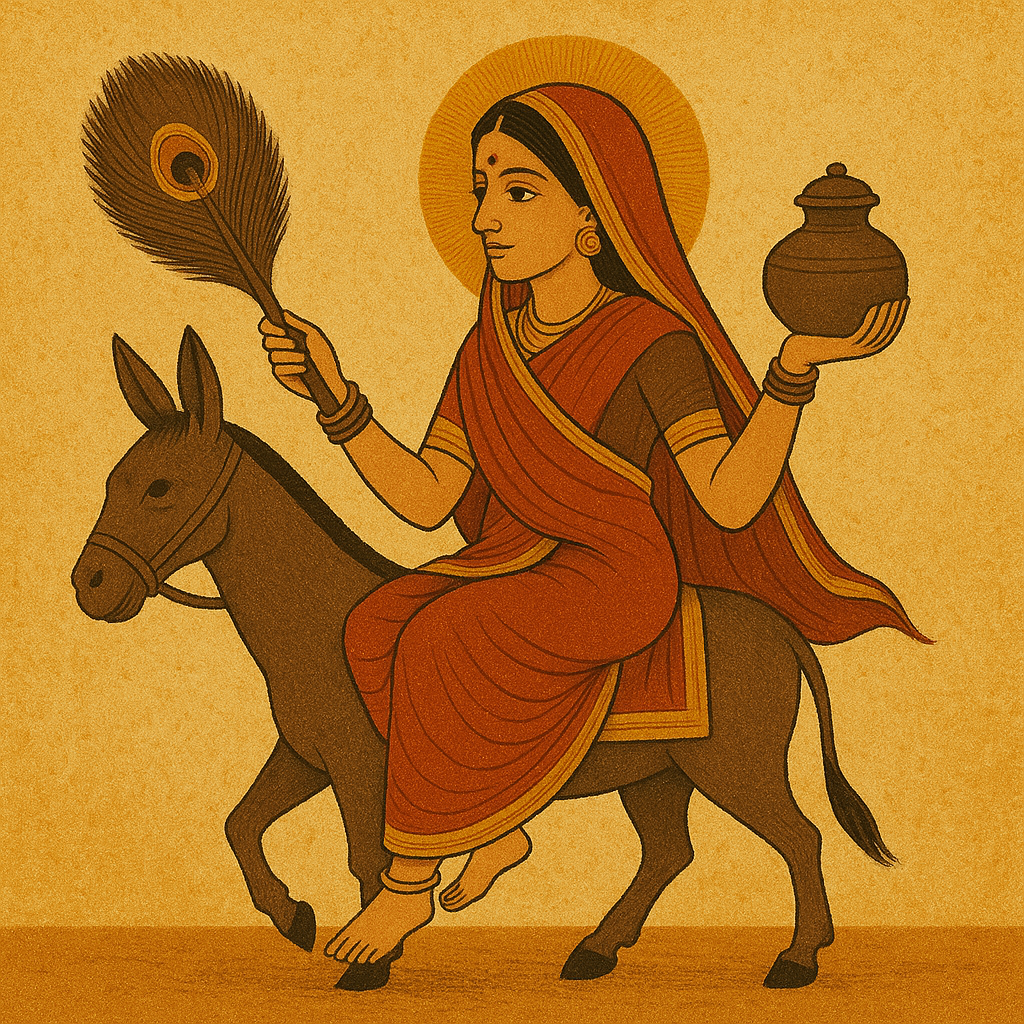
Kamika Ekadashi falls on the 11th day of New Moon phase (8th Aug 2026), Krishna Paksha, of Shravan month (Ashadh), as per the Hindu calendar, which is July-August month. Observing Vrat or fast on Kamika Ekadashi brings many benefits to the devotee and appeases Bhagwan Vishnu. This special day, Ekadashi, is thought to wipe away all our wrongdoings, giving us a chance at ultimate freedom, known as 'moksha'. It's like a spiritual reset button, where we seek forgiveness and strive for a deeper connection with the divine, hoping for a fresh start and inner peace.
Meaning of Kamika Ekadashi:

In Hinduism, observing a vrat (fast) on Kamika Ekadashi is believed to bring greater blessings than taking a ritual bath in all of India's sacred rivers on auspicious days. Moreover, a devotee who faithfully completes the Kamika Ekadashi vrat is thought to receive more blessings from the Lord than someone who has visited all the major Hindu holy sites, such as Kashi, Haridwar, and Kedarnath. Fasting on Kamika Ekadashi is believed to be as powerful as reciting all the scriptures dedicated to Shri Vishnu. The greatest benefit of observing this vrat is achieving Vaikunhta Prapti, or salvation in Vishnu Lokam. This means that Yamadharmaraj, the God of death, will not interfere with the devotee's devotion.
Kamika Ekadashi Significance:
If someone who has committed a terrible sin, such as killing an innocent person, a Brahmin, a pregnant woman, or a devout and pure woman, learns about the virtues of Kamika Ekadashi, they are forgiven for their transgressions.
However, this does not mean that one can deliberately commit such sins thinking they will be absolved simply by learning about Kamika Ekadashi. Deliberate sinning with this mind-set is considered abhorrent.
Hearing about the glories of Kamika Ekadashi with sincere faith purifies a person of all sins and ensures they reach Vishnu-Loka, or Vaikuntha. This marks the conclusion of the Brahma-Vaivarta Purana's account of the Shravana-Krishna Ekadashi, also known as Kamika Ekadashi, and its blessings.
Kamika Ekadashi 2026: Tithi & Muhurat (Date & Time)
Kamika Ekadashi on Saturday, August 8, 2026
On 9 th Aug, Parana Time - 02:35 PM to 05:35 PM
On Parana Day Hari Vasara End Moment - 11:48 AM
Ekadashi Tithi Begins - 09:29 AM on Aug 08, 2026
Ekadashi Tithi Ends - 06:34 AM on Aug 09, 2026
Kamika Ekadashi Parana
Gauna Kamika Ekadashi on Sunday, August 9, 2026
On 10 th Aug, Parana Time for Gauna Ekadashi - 05:38 AM to 08:37 AM
On Parana Day Dwadashi would be over before Sunrise
Ekadashi Tithi Begins - 09:29 AM on Aug 08, 2026
Ekadashi Tithi Ends - 06:34 AM on Aug 09, 2026
The fast must be broken after sunrise the next day of Ekadashi. Note that one should break the fast (Parana) within Dwadashi Tithi. Another important consideration is that one must not break the fast-during Hari Vasara which is the fourth duration of Dwadashi. The best time to break the fast is Pratah kala (early morning).
Kamika Ekadashi Presiding Deity:

Bhagwan Shridhar, is the presiding Deity of Kamika Ekadashi and Shridhar is one of the names of Bhagwan Vishnu, depicted in the same way as Shri Vishnu images, with Shankh, Chakra, Gada, Padma held in his four hands. Shridhar means the consort of Goddess Laxmi or Shri.
What to do on Kamika Ekadashi:
Kamika Ekadashi on Saturday, August 8, 2026

- On the morning of Ekadashi, take a bath early in the morning. The devotee should intent on keeping the fast with sincerity.
- Worship Shridhar/Vishnu with dedication. Offer Bhog, flowers, etc. to him at home.
- Light a Ghee Lamp in honour of Lord Vishnu.
- Remain in a spiritual higher state. Chant Mantras and praises of Vishnu, sing Bhajans, through the day. Visiting Lord Shridhar/ Vishnu/Krishna Mandir on Ekadashi is commonly followed by devotees.
- Stay awake through the night of Ekadashi, in full consciousness. Play Music for Vishnu/Shridhar, through the night if possible. If the devotee falls asleep on Ekadashi night, then the Vrat is incomplete.
Kamika Ekadashi Vrat & Puja Significance:

Observing the Kamika Ekadashi Vrat is equivalent to taking bath in holy River Ganga and other holy rivers, visiting Kashi (Varanasi) and performing Yajnas. It is a day to worship Shri Vishnu in Sridhar form and garner his blessings. When Kamika Ekadashi is followed meticulously, the devotee is blessed with peace, prosperity and fulfilment of wishes. It helps to get relief from Pitra Dosha and helps ancestors. This virtuous Ekadashi absolves sins and brings salvation. Observing the Kamika Ekadashi Vrat in the Shravan month and worshipping Bhagwan Vishnu brings benevolent benefits to the devotee.
Kamika Ekadashi Vrat Vidhi (Fasting Procedure):
For fasting on Kamika Ekadashi, the Vrat Vidhi should be followed by devotees to ensure successful completion of the Vrat.
- Kamika Ekadashi Vrat starts on the morning of Ekadashi and the Sankalp(intension) of observing the Vrat(fast) should be taken after having bath early in the morning.
- Invoke and worship Lord Shridhar/Vishnu.
- The best fasting is dry fasting, Nirjala Vrat, which means, fasting without drinking water and food. However, devotees should be aware of what their body and health and fast accordingly. Commonly devotees abstain from eating any food but drink water.
- Beans and grains are prohibited to eat on Ekadashi for devotees who are fasting by eating one meal on Ekadashi. Non vegetarian food, onion, garlic is strictly not allowed on Ekadashi and Dwadashi.
- Sleeping during the day or night during Ekadashi Vrat is prohibited. The devotees should chant/ sing praises of Lord Vishnu/Krishna, read the Bhagawat Geeta and other holy books through the day and night.
- Indulging in gossiping, talking/thinking ill of others or self, does not give the desired outcome of the Ekadashi Vrat.
- Abstinence from alcohol, drugs, tobacco, other addictions, sex on Ekadashi and Dwadashi has to be observed.
- Maintain calmness, avoid anger/aggression for the best outcome of observing the Kamika Vrat.
- Distribute the Prasad to family members and as many people as possible on Dwadashi.
- Devotees who observe fast should not eat food in other people's house on the day after Ekadashi.
- The next morning give charity to Brahmanas respectfully ask them for forgiveness for any offence. Donating to the needy is also advised which garners Bhagwan Vishnu's blessings.
- For people who observe Kamika Vrat, when breaking the fast, one should say the prayer - 'O Pundarikaksha, O lotus-eyed Lord, now I will eat. Please shelter me'.
- After the prayer the devotee should offer flowers and water at the lotus feet of rhe supreme God Vishnu and request Bhagwan to eat by chanting the mantra of eight-syllable, thrice: “Om Namah Narayanaya”. To garner the full merits of the fast, the devotee should have water which has been offered to the God.
- On Dwadashi only one meal should be eaten, and Honey and Urad-dal (black lentil) is not to be consumed.
- For devotees observing fast, if due to some unavoidable reason they are not able to break the fast on Dwadashi during Prana time, then drinking water to signify breaking of fast is advised. Later food can be eaten as per convenience.
Kamika Ekadashi Vrat (Fasting) Benefits:
-Benefits.jpg)
Kamika Ekadashi holds significance in Hindu tradition, believed to offer spiritual and worldly benefits to its observers:
- Spiritual Purification: It's thought to cleanse the soul of past sins, fostering spiritual growth.
- Attainment of Moksha: Like other Ekadashis, it's believed to lead to liberation from the cycle of birth and death.
- Blessings from Bhagwan Vishnu: Devotees seek blessings and grace from Lord Vishnu by fasting and worshiping.
- Removal of Obstacles: Observance can remove hurdles, promoting harmony and prosperity.
- Atonement: Observers seek forgiveness for past misdeeds, finding inner peace.
- Fulfillment of Desires: Prayers are made for wishes to be granted, trusting in divine power.
Overall, Kamika Ekadashi offers devotees a chance for reflection, renewal, and divine favor.
Prohibited Food Items for Kamika Ekadashi

During Kamika Ekadashi fast, devotees typically cease from consuming grains, lentils, certain vegetables, and specific spices. Here are some food items that are usually avoided during this fast:
- Grains: Wheat, rice, barley, corn, millet, etc. are avoided as they are grains.
- Lentils and Legumes: Beans, chickpeas, lentils, peas, etc. are avoided due to their grain-like properties.
- Onions and Garlic: These are believed to increase urges and therefore are generally avoided during Ekadashi fasting.
- Brinjal (Eggplant): Some people avoid brinjal as it is believed to be tamasic (having qualities of passivity).
- Mushrooms: Similarly, mushrooms are considered tamasic and are avoided by some during Ekadashi fasting.
- Hing (Asafoetida): Some people avoid “hing” as it is believed to disturb the purity of the mind during fasting.
- Non-vegetarian Food: All forms of meat, fish, and eggs are avoided during the fast.
- Alcohol and Stimulants: Consumption of alcohol and stimulants like caffeine is prohibited during Ekadashi fasting.
- Fermented Foods: Fermented foods like yogurt, cheese, and vinegar are often avoided.
- Processed Foods: Packaged and processed foods containing additives, preservatives, and artificial flavors are generally avoided as they are considered impure.
Devotees usually settle for a simple diet consisting of fruits, nuts, milk products, root vegetables (like potatoes), and specific types of flours (such as water chestnut flour or Singhara flour) to prepare dishes. However, dietary preferences may vary based on regional customs and personal beliefs. It's necessary for individuals observing the fast to cohere to the guidelines prescribed by their tradition or spiritual beliefs.
Kamika Ekadashi Vrat Katha (Traditional Story of the Fast):
.jpg)
The Kamika Vrat Katha narrates that once there lived a pious man, who was physically very strong, but had a lot of anger and aggression. One fine day the man had an argument with a Brahmin and in rage he killed the Brahmin. It was a crime and especially killing a Brahmin is considered a big sin. He wanted to do some austerity to wash away his sins. He met a Sadhu (Saint) and asked how he could be relieved of such a sin. The Sadhu advised him to observe the Kamika Ekadashi fast, following all the rules and sincerely praying to Bhagwan Vishnu. The man observed the Kamika Ekadashi strictly and prayed to Sridhar (Vishnu) with clear intention and was relieved from the sin.
Kamika Ekadashi Puja & Vrat (Fasting) Mantras:
On Kamika Ekadashi Lord Vishnu/Krishna are chanted.
Mantra:-
Om Namo Narayanaya
Om Namah Bhagavate Vasudevaya
Hare Krisha, Hare Krishna, Krishna Krishna Hare Hare.
Kamika Ekadashi Puja Vidhi - Pooja Procedure:

- On Kamika Ekadashi after taking a bath early in the morning and wearing fresh clothes, take sankalp of Vrat/fast to put forward your intention.
- Light a Ghee Lamp in your Puja Mandir/Alter
- Perform Abhishek of Shridhar/Vishnu with Gangajal (holy water of Ganges River) and Tulsi leaves. Devotees who have the sacred Shaligram Shila at home will perform Abhishek of Shaligram. Tulsi leaves are very important for worshipping Vishnu as they are His favorite.
- Offer fresh flowers and offer Bhog.
- Perform Aarti of Bhagwan Shirdhar.
-
Chant Bhagwan Vishnu Mantras. Reciting the Vishnu Sahasranama on Ekadashi is meritorious.
You can read or recite Vishnu Sahasranama (A thousand names of Vishnu). You can find it here.
- On this day Goddess Laxmi (consort of Bhagwan Vishnu) and Tulsi is worshipped too.
- Constantly chant Vishnu Mantras, sing his praises through the day and night.
- It is the best time for Havan, rituals and fasting. At least one of them must be performed to please Bhagwan Vishnu if possible.
- It is the best time to wear Rudraksha beads ruled by Narayana. A Ten Mukhi Rudraksha bead ruled by Bhagwan Krishna and a Nineteen Mukhi Rudraksha bead ruled by Shri Narayana is best to energise your devotional mood.
NOTE: For professional and devoted Puja services you may reach out to Rudra Centre.We have 250+ qualified “Karm-kandi” Pandits from Kashi specially curated by Sakhashree Neeta ji.
Kamika Ekadashi Puja Benefits:

The Puja of Shridhar (Vishnu) on Kamika Ekadashi blesses the devotee and family with good health, prosperity, wealth, righteous living, spiritual progress, happy family, contentment, worldly comforts, joy, protection and abundance.
Kamika Ekadashi “Daan” (Donation):
.jpg)
Donation on Kamika Ekadashi is considered highly auspicious and commendable. Here are some suggested items to donate on this sacred day:
Food items:
- Rice, wheat, and other grains.
- Fruits and vegetables.
- Cooked meals to the needy and hungry.
Click Here to Book Food Donation (Ann Daan)
Clothing:
- New clothes for the poor and underprivileged.
- Warm clothes, blankets, and shawls, especially in cold areas or winter seasons.
Click Here to Book Clothes Donation (Vastra Daan)
Money and benefaction:
- Financial donations to temples, charitable organisations, or directly to those in need.
- Supporting the education of underprivileged children by donating to schools or educational charities.
Religious Items:
- Books on spirituality and religious scriptures.
- Items used in worship like incense sticks, diyas (lamps).
Shelter and Support:
- Donating to shelters for the homeless or animal shelters.
- Contributing to the construction of schools, hospitals, and community centres.
Cows and Animal Care:
- Donating to goshala (cow shelters) or animal welfare organisations.
- Providing food & fodder and other essentials for animals.
Click Here to Book Cow Donation (Gau Daan)
While making donations, it's important to do so with a pure heart and the intent to help and uplift others. This selfless act of charity not only benefits the recipients but also brings spiritual merit to the donor. Observing these practices on Yogini Ekadashi is believed to cleanse one's soul, remove past sins, and attract divine blessings.


-in-Astrology.jpg)






.jpg)




Kavitha M
|June 15, 2025
Nice Story